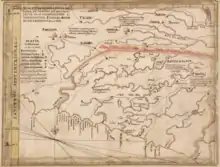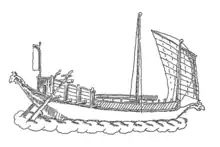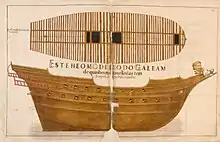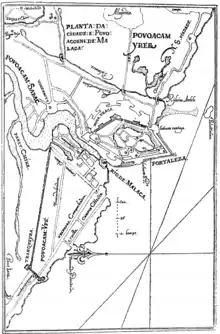Malay-Portuguese conflicts
Malay-Portuguese conflicts refer to the military engagements between the forces of the Portuguese Empire and the various Malay states and dynasties, fought intermittently from 1509 to 1641 in the Malay Peninsula and Strait of Malacca.
| Malay–Portuguese conflicts | |||||||
|---|---|---|---|---|---|---|---|
| Part of Portuguese presence in Asia | |||||||
_(14743853356).jpg.webp) Portuguese sketch of Malacca ca. 1550 to 1563. | |||||||
| |||||||
| Belligerents | |||||||
|
Supported by:
| |||||||
| Commanders and leaders | |||||||
|
Mahmud Shah of Malacca | ||||||
Background
In 1498, after decades of exploratory efforts, the Portuguese navigator Vasco da Gama reached India, landing at Calicut. He returned to Lisbon in 1499, ushering a new age of European presence in the East.
King Manuel wished to become involved in the Indian Ocean trade network, expecting to derive great profits from importing spices to Europe via the Cape Route, bypassing the numerous middle-men that traded in valuable merchandise through the Red Sea, Egypt and the Middle-east, where they were acquired by Venetian merchants and sold in Europe.
The existence of the wealthy trade hub of Malacca became known to King Manuel of Portugal since at least 1505, from second-hand information collected by captains in India. The port city of Malacca controlled the narrow, strategic Strait of Malacca, through which all seagoing trade between China and India was concentrated. He dispatched a trade mission under the command of Diogo Lopes de Sequeira, tasked with making contact with the city and establish friendly trade relations.
War against Sultan Mahmud, 1509–1526
Battle of Malacca, 1509
Diogo Lopes de Sequeira successfully reached the city and was warmly welcomed by the local Sultan Mahmud, who granted the Portuguese commander authorization to establish a feitoria or trade post. Wary of their interests, the influential Muslim merchant community of the city conspired with the Sultan and managed to convince him to turn on the Portuguese.[1]
The Portuguese ships lying in the harbour were unexpectedly attacked by the Malaccan fleet, and Sequeira returned to India, leaving behind a number of prisoners on land that were captured, imprisoned, and tortured.[2]
Portuguese Conquest of Malacca 1511
.png.webp)
The Portuguese left behind by Sequeira at Malacca were headed by the factor Rui de Araújo, who managed to slip letters to the governor of India Afonso de Albuquerque from prison with the aid of a dissatisfied Hindu merchant, Nina Chatu.
Afonso de Albuquerque subsequently led an expedition of 16 ships, 700 Portuguese soldiers and 300 Malabarese auxiliaries that succeeded in wresting the city from the unpopular Sultan Mahmud, with the support of part of its population, after a military operation that lasted two months from July 1 to September 1. Albuquerque subsequently built a fort, established various institutions in the city, and confirmed religious freedom to its inhabitants. Malacca became a stepping stone for future Portuguese endeavours in the region and further afield, whether exploratory, diplomatical or commercial.
The capture of Malacca was the result of King Manuel intentions to beat the Castilians to the Far-East, and Albuquerques own plan of establishing firm foundations for Portuguese India, alongside Hormuz, Goa and Aden, to ultimately control trade and thwart Muslim shipping in the Indian Ocean.[3] The Portuguese conquest of Malacca was a watershed event that led to the reshaping of the southeast Asian region.[4]
Battle of Pago, 1520
Sultan Mahmud was evicted but survived the Portuguese conquest of Malacca. He built a fortified camp at Pago, from where he harassed Malacca, expecting to reatake the city at a later date.[5]
With reinforcements sent from Goa, the captain of Malacca Garcia de Sá was able to force all of Mahmuds men in the vicinity of Malacca.[6] António Corria then successfully assaulted Sultan Mahmuds camp at Pago with a 150 Portuguese and 300 Malay auxiliaries on a small flotilla of 2 carracks, 1 caravel, 2-4 galliots and a number of native Malay lancharas, forcing him to withdraw to Pahang, and from there to the Bintan, an island-kingdom which he usurped.[6][7]
Battle of Bintan, 1521
In 1521 the captain of Malacca Jorge de Albuquerque made an attack on Bintan with 18 ships and 600 men.[8] Due to a lack of familiarity of the geography of the region, particularly its shallow waters, the Portuguese withdrew after losing 20 men and one light oarship.[8] Afterwards, Sultan Mahmuds raids on Malaccan shipping increased.
First Battle of Pahang, 1522
following the marriage alliance established in the same year between Sultan Mahmud and the deposed Sultan of Melaka, Mahmud Shah of Bintan. Ignorant of this development, Albuquerque sent three ships to the port of Pahang for provisions, where two of his captains and 30 men were killed. The third made his escape, but was slain with all his men at Java. Simon Abreu and his crew were slain on another occasion.[9]
Second Battle of Pahang, 1522
in 1522 a Portuguese fleet under the command of Antonio de Pina and his assistant Bernaldo Drago, who had landed at Pahang port,[10] in ignorance that the Sultan there was a son-in-law of Sultan Mahmud of Bintan, were ambushed and killed. The captured survivors were sent to Bintan and forced to embrace Islam, while those who refused were executed with blowing from a gun.[11]
Battle of Muar river, 1523

In early 1523, the Sultan of Malacca and the Sultan of Pahang Sultanate established a base within Muar River, from which raided the naval supply lines of the Portuguese at Malacca.[12]
The captain of Malacca Jorge de Albuquerque detached a flottilla to face the Malays within the river and disperse them in April, however a heavy storm scattered the ships of the Portuguese, and three were ambushed and 65 soldiers killed upon entering into Muar.[13] The Malays then withdrew.[13]
Siege of Malacca 1524
Sultan Mahmud besieged Malacca in May with a fleet of 80 oarships and 16,000 men led by a Portuguese renegade.[14] The Portuguese garrison numbered 200 soldiers supported by the corps of native Malay auxiliaries and after a month the attackers withdrew to Bintan, shortly before the arrival of Portuguese reinforcements.[14]
Third Battle of Pahang, 1524
After having arrived at Malacca with reinforcements, Martim Afonso de Sousa relieved the city, and pursued the admiral of Malacca into Bintan, which he blockaded for three months.[14] Thence he proceeded to Pahang, destroyed all the vessels in the river and slew over six hundred people in retaliation for the assistance given to the Sultan of Malacca. Numbers were carried into slavery.
Battle of Patani 1524
In June of 1524, Martim Afonso de Sousa destroyed 36 junks at anchor at Patani, which had allied with Pahang and Bintan, and torched the city, including the sorrounding dusun cropfields, orchards and palm groves.[15] For the next two weeks he captured or destroyed another 70 junks arriving from Siam or Java.[15] The following year, a peace between Patani and Portugal was achieved by the new captain of Malacca, Pedro de Mascarenhas (1525-1526), who had dispatched a mission to Pahang led by Martim Afonso de Melo Jusarte.[15]
Battle of Lingga, 1525

In 1525, two Portuguese carracks and 80 soldiers under the command of Álvaro de Brito and António Raposo sent to the aid of an allied ruler, the Sultan of Lingga, repulsed a larger joint fleet of Sultan Mahmud and the Sultan of Indragiri, numbering 160 lancharas and 2000 men, close to the Ligga archipelago.[16]
Siege of Bintan, 1526
Taking advantage of the unusually large numbers of soldiers available in Malacca, captain Dom Pedro Mascarenhas decided to undertake a vigorous campaign on Bintan that neutralize Sultan Mahmud once and for all.[17]
With 15 ships, 600 Portuguese soldiers, 300 Malay auxiliaries and an unrecorded number of sailors and combat-slaves, Dom Pedro blockaded the island-kingdom of Bintan and set siege to its capital city.[17] Despite the difficult terrain which favoured defense and Sultan Mahmud having had aid from the Sultan of Pahang, the outnumbered Portuguese overcame every ordeal and assaulted the city by surprise one night, driving away all defenders.[18] Bintan was razed and the territory returned to its previous, rightful ruler.

Sultan Mahmud survived the destruction of Bintan, and escaped to Sumatra, where he ultimately perished. The defeat of the former Sultan of Malacca at Bintan impressed many rulers around the Strait, who sent embassies seeking treatie with the Portuguese, which afforded Malacca great prosperity for many years thereafter.[19]
First Luso-Johor War 1533-1536
After the destruction of Bintan and the death of Sultan Mahmud, his son Alauddin Riayat Shah II of Johor founded the sultanate of Johor on the Malaysian mainland, who was hostile towards the Portuguese in Malacca. In 1533 the Sultan of Johor had a Portuguese ambassador publicly tortured to death with boiling water, which amounted to a declaration of war.[20] Transgressions on the lives of ambassadors and messengers were highly contrary to Portuguese (and European) procedure, but common in Asia.[20]
In May 1534, a small Johor fleet of 17 oarships clashed with a Portuguese flotilla near the Muar river and killed Dom Paulo da Gama, son of Vasco da Gama and brother of the captain of Malacca Dom Estevão da Gama.[20]
Battle of Ugentana, 1535
After the death of his brother Paulo, the captain of Malacca Estevão da Gama attacked Johor on June 1535, with a carrack, a square-rigged caravel and 18 light oarvessels with about 400 Portuguese soldiers plus 400 "combat slaves".[21] The Portuguese sailed up the river which led to Johor and engaged its defenses but the Sultan fled to the jungle under the cover of the night.[21] The Portuguese captured a number of vessels, spoils and artillery in the city, which was then razed.[21]
Battle of Ugentana, 1536
.jpg.webp)
In 1535 the sultan avoided the total destruction of his forces by abandoning the city and retreating into the jungle, while most of his fleet was out at sea the time. Hence, he was able to rebuilt his city and continue harassing the navigation of Malacca after the Portuguese had left, though weakened after the Portuguese captured their artillery the previous year. Dom Estevão departed from Malacca with a carrack, a number of light oarships, 400 Portuguese soldiers, 400 auxiliaries and an unrecorded number of combat slaves with arquebuses.[22]
The Portuguese engaged the sultans forces close to Johor, and managed to capture the Johor fleet.[22] The sultan witnessed the battle from atop an elephant, and again attempted to evacuate into the jungle, but he suffered a revolt and his baggage train carrying his treasure was assaulted mid-retreat by his own fleeing forces.[22] Under these conditions, he sought terms with the Portuguese, but Dom Estevão only trusted the sultan with a treaty after his uncle was given up as a valuable hostage.[22]
With the capture of the Johor fleet, navigation in the strait of Singapore became much safer and trade increased.[22][23]
Later conflicts
Siege of Malacca 1551
The Sultan of Johor disregarded the peace treaty signed in 1536 and organized a large fleet that included the allied forces of the Sultanate of Johor, the Sultanate of Perak, the Sultanate of Pahang and the Sultanate of Jepara in Java to attack Portuguese Malacca in 1551.[24] It included 200 ships, of which about 150 were oarships and about 40 were Javanese junks, and 10,000 men, of which 6000 were Malays and 4000 Javanese.[24] The garrison of Malacca numbered 400 Portuguese.[24]
An attempt to lure the garrison out failed and Malacca was besieged. Failing to overcome Portuguese defenses or sever the naval supply lines of the city after three months, the Malays withdrew when they heard rumours put into circulation by the captain of Malacca Dom Pedro da Silva that the Portuguese were about to attack their coastal cities.[24][25] The Javanese were then defeated by the Portuguese in battle and forced to reembark, having suffered heavy losses.[24][25] Most Portuguese casualties were caused in the aftermath, by poisoned water wells.[24]
Siege of Johor, 1587

In 1586 naval forces of Johor began diverting shipping to the Singapore Strait.[26] A large Johor fleet attempted to attack Malacca itself, but was driven back by the presence of heavily armed galleons in its harbour.[27] The captain of Malacca João da Silva requested urgent reinforcements from Goa and the viceroy Dom Duarte de Meneses dispatched 500 men and 3 galleons, under the command of Dom Paulo de Lima to deal with the threat.
The forces of Johor were incapable of preventing the heavy Portuguese infantry from landing and storming the city after a naval bombardment, and its Sultan was forced to retreat into the jungle in a rout.[28] The Portuguese captured ample spoils, which included over 1,000 cannon, the great majority of them of small caliber, 1,500 firearms, and burned upwards of 2,000 craft of many sizes.[29] Following the attack, Dom Pedro de Lima also sacked Bintan, then a vassal of Johor.[30]
Siege of Malacca, 1606
In 1606, Dutch VOC admiral Cornelis Matelief besieged Malacca with the support of the ruler of Johor, Sultan Alauddin Riayat Shah III of Johor who signed an alliance in May.[31] In exchange, the Dutch would get Malacca for themselves and would be able to conduct trade with Johor.
The small Portuguese garrison, under the command of André Furtado de Mendonça managed to hold out and stop any Dutch direct attacks on the city until additional reinforcements could arrive led by Martim Afonso de Castro, which made the Dutch retreat from the siege. After they retreated, the Dutch were again defeated by the Portuguese at the Battle of Cape Rachado.
Johor expedition, 1607

After Johor had signed an alliance with the Dutch East India Company in 1606, Portuguese naval forces had kept the Johor River under blockade, thereby severing the sultanates trade and communications.
On December 15, 1607, a Portuguese naval force numbering 13 galleons anchored before the city in preparation for an attack.[32] Further military action however, proved unnecessary. Upon spotting the Portuguese, the Sultan of Johor panicked, set his capital on fire and hurriedly evacuated it to the jungle, along with the resident Dutch merchants. The Portuguese destroyed the Johor fleet and so achieved their objectives through a demonstration of sea power.[32]
In 1610, Johor signed an peace agreement with the Portuguese.
Siege of Malacca, 1641

After years of intermittent conflict, the Dutch East India Company had amassed a force of 2,000 Europeans at Batavia by August 1639, with the intent of sending the troops to Malacca. In early May 1640, the government of Batavia resolved to capture Malacca, whether by negotiation or violence. The previous commander, Cornelis Symonz van der Veer, had died since then, so Sergeant Major Adriaen Antonisz was sent in his place. The Portuguese were led by Governor Manuel de Sousa Coutinho. Their city was heavily fortified, with 32-foot-high (9.8 m) walls that could stand bombardment from both sides. The citadel possessed 70 heavy guns and between 40 and 50 lighter ones. The Portuguese garrison consisted of 260 men, although the Dutch claimed that the best soldiers in the defence were the native and mixed-racial inhabitants, who numbered about 2000–3000 in total. They also claimed that only a powerful European army was capable of bringing it down.[33]
The Dutch They had support from Javanese and Bandanese allies, as well as Mardijkers, who numbered 95 in all.[33] Their Johor allies brought 500–600 men of their own.[33] After an over five-month siege, Malacca was seized by the Dutch East India Company, ending nearly 130 years of official Portuguese presence in the region.
See also
References
- João Paulo de Oliveira e Costa, Vítor Luís Gaspar Rodrigues (2012) Campanhas de Afonso de Albuquerque: Conquista de Malaca, 1511 pp. 25–26.
- João de Barros, 1553, Décadas da Ásia decade 2, book 4, ch. 4
- João Paulo de Oliveira e Costa, Vítor Luís Gaspar Rodrigues (2012) Campanhas de Afonso de Albuquerque: Conquista de Malaca, 1511 p. 13.
- Anthony Reid: Verandah of Violence: The Background to the Aceh Problem, 2006, Singapore University Press, p. 39.
- Saturnino Monteiro: Batalhas e Combates da Marinha Portuguesa 1139-1975 volume I, 2013 edition, pp.364-368.
- Monteiro, 2013, volume I, pp. 378-383.
- Malay Annals, Longman, Hurst, Rees, Orme, and Brown, 1821, pp.357-358.
- Danvers, Frederick Charles, The Portuguese In India Vol.1, p. 349
- Journal of the Straits Branch of the Royal Asiatic Society, p. 142
- Buyong Adil, Sejarah Pahang ('History of Pahang'), Dewan Bahasa dan Pustaka, p. 53
- Linehan, William (1973), History of Pahang, Malaysian Branch Of The Royal Asiatic Society, Kuala Lumpur, p. 20
- R. S. Whiteway, Rise of Portuguese Power in India, p. 329.
- Danvers, Frederick Charles, p. 358.
- Saturnino Monteiro: Batalhas e Combates da Marinha Portuguesa 1139-1975, volume II, Livraria Sá da Costa Editora, 1991, p. 35.
- Jorge Santos Alves, « A. Patani and the Luso-Asian Networks (1516-1642) », Archipel [En ligne], Hors-Série n°2 - Patani Through Foreign Eyes: Sixteenth And Seventeenth Centuries (Edited By Daniel Perret & Jorge Santos Alves) | 2022, mis en ligne le 28 février 2022, consulté le 25 septembre 2023. URL : http://journals.openedition.org/archipel/2799 ; DOI : https://doi.org/10.4000/archipel.2799
- Saturnino Monteiro: Batalhas e Combates da Marinha Portuguesa 1139-1975, volume II, Livraria Sá da Costa Editora, 1991, p.75.
- Saturnino Monteiro: Batalhas e Combates da Marinha Portuguesa 1139-1975 volume II, Livraria Sá da Costa Editora, 1991, p.103.
- Monteiro: 1991, pp. 105-110.
- Gaspar Correia, Lendas da Índia 1862 edition, tome III, Academia Real das Sciencias de Lisboa, p. 92.
- Saturnino Monteiro: Batalhas e Combates da Marinha Portuguesa 1139-1975, volume II, 1991, Livraria Sá da Costa Editora, pp. 231-233
- Saturnino Monteiro: Batalhas e Combates da Marinha Portuguesa 1139-1975, 1991, Livraria Sá da Costa Editora, p.239-242.
- Saturnino Monteiro: Batalhas e Combates da Marinha Portuguesa 1139-1975, 1991, Livraria Sá da Costa Editora, p.267-269.
- M. A. P. Meilink-Roelofsz: Asian Trade and European Influence: In the Indonesian Archipelago between 1500 and about 1630 , Springer Science & Business Media, 2013, p.141.
- Saturnino Monteiro: Batalhas e Combates da Marinha Portuguesa 1139-1975 volume III, Livraria Sá da Costa Editora, 1992, pp. 129-135.
- Frederick Charles Danvers: The Portuguese in India: A.D. 1481-1571, W. H. Allen & Co. Limited, London, pp. 494-495.
- Saturnino Monteiro (2011), Portuguese Sea Battles 1580-1603 pp.170-174
- Monteiro (2011), pp.176-179
- Diogo do Couto Da Ásia, Década Nona 1788 edition, volume II, pp. 473-503.
- Couto, p. 507.
- Couto Da Ásia, Década Nona 1788, volume II, p. 629.
- The two treaties signed on 17 May and 23 September 1606 are reprinted and translated into English in Borschberg, Hugo Grotius, the Portuguese and Free Trade, appendix 14, pp. 215-223.
- Saturnino Monteiro (1994), volume V, p. 72.
- Leupe, P.A.; Hacobian, Mac (1936). "The Siege and Capture of Malacca from the Portuguese in 1640-1641". Journal of the Malayan Branch of the Royal Asiatic Society. 14 (1 (124)): i–iii, 1–178. ISSN 2304-7550. JSTOR 41559848.